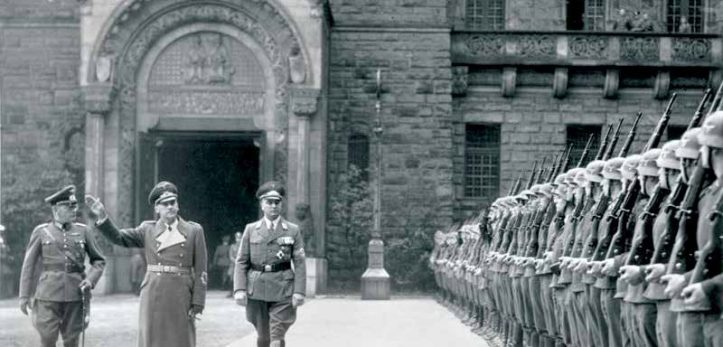The anti-Catholic propaganda of German National Socialism. Part 3
Author: Grzegorz Kucharczyk,
"Love One Another!" 34/2016

A few months before the outbreak of the Second World War, Peter EschŌĆÖs book Polen kreuz und quer. Blicke hinter die Kulissen [The length and breadth of Poland: a look behind the scenes] was published. It was a reportage from the authorŌĆÖs trip all over Poland and represents a magnificent example of a propaganda attack on the Polish Church and Polish Catholicism.

Confusing truth with lies
The anti-Catholic propaganda of German National Socialism acquired a particularly forceful character in the context of the Third ReichŌĆÖs aggressive policy towards Poland. In the spring of 1939, when Hitler even more furiously demanded that Poland meet his conditions (which actually boiled down to the country submitting without a single shot being fired), the anti- Polish propaganda intensified, including blaming the Polish Catholic Church for instigating Polish nationalism.
Nazi propagandists, controlled by Joseph Goebbels, who was an acknowledged expert in the field of misinformation and manipulation, were well aware of the fact that in order to get the best results in their propagandist endeavours, it was a good idea to mix lies with truth in the right proportions.
Peter EschŌĆÖs book Polen kreuz und quer. Blicke hinter die Kulissen [The length and breadth of Poland: a look behind the scenes] had been published before the Second World War. It was a reportage from the authorŌĆÖs trip across Poland and represents a magnificent example of a propaganda attack on the Polish Church and Polish Catholicism.
On the one hand, Esch is absolutely correct when he writes that ŌĆ£for the Polish people, being Polish equates to CatholicismŌĆØ. In the Polish homeland, Catholicism was the main weapon in the Polish nationŌĆÖs fight for freedom against the partitionersŌĆØ. On the other hand, it brings the reader to the erroneous conclusion that ŌĆ£the role of the Polish clergy in the development of Polish nationalism and the notion of Polish nationhood has a centuries-old traditionŌĆØ and that ŌĆ£Poland and its nationalism cannot be fully understood if the role of the Catholic Church is not taken into accountŌĆØ.
In this case, the misinformation consists not only in mixing truth and lies, but with regard to the latter we are dealing with the confusion of two concepts: the notion of patriotism and the notion of nationalism. The role of the Polish Catholic Church in the formation of Polish patriotism (since the Middle Ages) cannot be overestimated, but it is a different story with nationalism, which has never been advocated by the Church in Poland (nor in any other country); on the contrary, it has been denounced. During the interwar period, when Esch visited Poland, he failed to notice that it was not the Church that was drifting towards nationalism, but the nationalist movements, which at the same time were losing their primitive social Darwinism (the notion that in international relations ŌĆ£only the fittest surviveŌĆØ) and abandoning the idea of national ethics (the idea that a different code of ethics is observed in relations among individual human beings than among nations).
What did a Nazi see before his eyes in Cz─Östochowa?
The monastery of Jasna G├│ra in Cz─Östochowa and its significance to Poland and Polish Catholicism received special attention from the Nazi propagandist. For him, the miraculous painting of Our Lady of Cz─Östochowa, also known as the Black Madonna, was nothing more than ŌĆ£the symbol of Polish nationalismŌĆØ. Esch observed: ŌĆ£The image of the Black Madonna, the Queen of the Polish Crown, symbolises the unique connection between the Catholic faith and Polish nationalism, which is really out of touch with reality, and in fact induces fatalistic faith and backward mythology.ŌĆØ
ŌĆ£Fatalistic faithŌĆØ and ŌĆ£backward mythologyŌĆØ ŌĆō in this way the National Socialist propagandist summed up the centuries-old spiritual bond of the Polish people with Jasna G├│ra, where, as John Paul II used to say, ŌĆ£beats the heart of the nation in its motherŌĆÖs heartŌĆØ.
That is why for centuries the image of Our Lady of Cz─Östochowa was put on Polish flags, which for the German author was proof that the Black Madonna was in some way connected to Polish nationalism. As Esch summed up: ŌĆ£even peasantsŌĆÖ sons, who blindly believe in the special powers of that image, were in some cases let down completelyŌĆØ.
At this point, we can indicate another characteristic feature of the propagandistic view of Polish Catholicism presented by German National Socialists, namely ridicule and attempts to denigrate the very things that Polish people held sacred. Taking this into account, we can fully understand the comment of the German propaganda journalist: it seems that the image of the Black Madonna, the symbol of Polish nationalism, is not a suitable weapon against all enemies. Contemptuously, Esch argued that ŌĆ£Our Lady of Cz─Östochowa didnŌĆÖt have anything againstŌĆØ the capture of Jasna G├│ra in 1793 by the Prussian army, and twenty years later in 1813 by the Russians.
Being the main rallying point for Polish minds, the Church permanently emanates in silence, acting as an eternal guiding light. If all the lights of hope were put out for Poland, there still would be Our Lady of Cz─Östochowa and the Church
ItŌĆÖs worth noting that the German National Socialists targeted Our Lady of Cz─Östochowa for particularly revolting attacks. A couple of years before EschŌĆÖs book was published ,when there was still a short period of detente between Poland and Germany, the Black Madonna was portrayed in the German press as ŌĆ£a kind of cross between a black woman and a Mongolian womanŌĆØ.
During the German Occupation of Poland in the Second World War, the Nazi leadership was well aware of the profound significance that the Queen from Jasna G├│ra had for the Polish people. At a meeting with his closest associates on 2 March 1940, Hans Frank, head of the Nazi Occupation Administration in the General Government, said: ŌĆ£I am wise enough to know that Holy Joes are our deadly enemies. [ŌĆ”] The Church was held in reserve as the last centre of Polish nationalism, as long as there were other ways and places to manifest national feelings. Being the main rallying point for Polish minds, the Church permanently emanates in silence, acting as an eternal guiding light. If all the lights of hope were put out for Poland, there still would be the Our Lady of Cz─Östochowa and the Church. [ŌĆ”]. In this country, Catholicism is not a faith; it is an absolute necessity for livingŌĆØ.
The devastating consequences of belligerent anti-Catholicism
Such was the predominantly anti- Catholic mindset with which the people responsible for shaping German occupation policy came to Poland in 1939. In addition to H. Frank, who has just been quoted, the most prominent representative of the anti- Catholic establishment was Arthur Greiser, head of the German occupation administration in Greater Poland, which was incorporated into the Third Reich (from then on, it was called ŌĆ£Warta LandŌĆØ, to avoid mentioning the name Poland; in German, Greater Poland is ŌĆ£GrosspolenŌĆØ).
Considering himself a model Nazi, Greiser wanted to transform Greater Poland into ŌĆ£a true testing ground for National SocialismŌĆØ. Among many other ŌĆ£exemplaryŌĆØ procedures, such as the extermination of the Polish elite, the expulsion of Poles from their land and homes, mass German colonisation and the extermination of Jews, GreiserŌĆÖs policy was mainly preoccupied with anti-Catholicism.
It should be noted that the head of the German occupation authorities in Greater Poland had officially declared his apostasy from Christianity before 1939 (the abandonment of the Church, in this case the Evangelical Church). He also ascribed to the conviction, established by the Nazi propaganda machine (see above), of a link between Polish nationalism and Polish Catholicism.
As a model Nazi, during a visit to Kiel in 1942, he was reported to say: ŌĆ£from history, you should know that the Polish Catholic clergy has always fought fiercely for Polish ethnic identity against the German nation. Not putting an end to the activities of the Polish clergy proved to be a fatal error for the Prussian authorities and the Prussian Government; on the contrary, it only strengthened the wind in the clergyŌĆÖs sails. [ŌĆ”] The clergy stayed neutral as long as there wasnŌĆÖt anything anti-German involvedŌĆØ.
Associating the clergy with the struggle for national liberation had terrible consequences for the Polish Church under German occupation. The annihilation of the Polish Catholic Church on Polish territories under the Nazi occupation had, in a way, dual priority in the programme of ŌĆ£subduing the German EastŌĆØ. In fact, it was not only the ideological enemy that was destroyed (the enemy identified by the National-Socialist ideology long before 1939), but also the main pillar of Polish national identity in the territories that were assigned for Germanisation. From the German authoritiesŌĆÖ point of view, the Polish Catholic clergy was one of the groups that were to be eliminated because of their negative influence on the security of the German Reich and the German nation (HitlerŌĆÖs decree of 7 October 1939 on reinforcing the status of the German language).
The destruction of the monument of the Sacred Heart of Jesus, in October 1939, in Pozna┼ä city centre (now Mickiewicz Square) was one of the first actions of that kind taken by the German authorities. The monument was erected in 1932, thanks to public donations from the inhabitants of Greater Poland (as a token of gratitude for the regaining of Polish independence). However, according to Greiser, the Sacratissimi Cordi was ŌĆ£a symbol of Polish hatredŌĆØ
Catholic priests, as well as other representatives of the Polish political and intellectual elite, were among the main victims of Operation Tannenberg, which the Germans launched as soon as they invaded Poland. In mid October 1939, in Greater Poland, now incorporated into the Reich, the first transportations of Polish priests to concentration camps were embarked upon by the German occupation authorities.
During the German occupation, 5 bishops, 1863 diocesan priests and 63 clerical students were killed by the occupying forces. 239 monks were tortured in concentration camps, 218 were executed (by firing squad) and 123 were killed in some other way. Also 89 Polish nuns were killed by the Germans (32 in concentration camps). The biggest number of Polish clergymen (1393) were kept prisoner in the German concentration camp in Dachau. 750 of them perished. Only 52 were released. Polish priests were also kept prisoner in Auschwitz-Birkenau, Mauthausen and Sachsenhausen.
The territories that were directly incorporated into the Third Reich (Greater Poland, Pomerania and the District of Łódź) suffered from the most ruthless repressions. The sheer scale of the atrocities committed against the Catholic clergy provides ample justification for calling it a genocide of the priesthood.
In Wrocław diocese, 49% of the clergy was murdered, in Chełm diocese 48%, and in the dioceses of Łódź and Poznań almost 37% and 31% respectively. In Polish Pomerania (the dioceses of Wrocław and Chełm), the National Socialists arrested about 460 of the 690 priests (according to still inaccurate estimates). 214 of them were murdered, including the entire cathedral chapter of Pelplin. The rest of the priesthood was driven out to the General Government (it was planned that 80% of the Polish Catholic clergy from the Polish territories incorporated directly into the Reich would be relocated there). Only 20 priests ministered in Pomerania until 1940.
The Polish church was subjected to persecutions not only in the territories incorporated directly into Germany. In the diocese of Warsaw alone, the National Socialists murdered 212 Catholic priests during the last war. The Third Reich adopted a similar policy against the Polish clergy in the eastern territories annexed by Germany after 22 July 1941. Suffice it to mention a tragic incident from 31 July 1943, during which the Gestapo arrested 11 nuns from the Congregation of the Holy Family in Nazareth who were carrying out their daily duties in the convent in Nowogr├│dek. The next day, they were executed by firing squad.
ŌĆ£Symbols of Polish hatredŌĆØ
The German occupation authorities made efforts to purge the public space of Catholic symbols, in particular those which they claimed to be proof that Catholicism was connected with Polish nationalism. The destruction of the monument of the Sacred Heart of Jesus, in October 1939, in Pozna┼ä city centre (now Mickiewicz Square) was one of the first actions of that kind taken by the German authorities. The monument was erected in 1932, thanks to public donations from the inhabitants of Greater Poland (as a token of gratitude for the regaining of Polish independence). However, according to Greiser, the Sacratissimi Cordi was ŌĆ£a symbol of Polish hatredŌĆØ.
From the German authoritiesŌĆÖ point of view, the Polish Catholic clergy was one of the groups that were to be eliminated because of their negative influence on the security of the German Reich and the German nation (HitlerŌĆÖs decree of 7 October 1939 on reinforcing the status of the German language)
Yet the ŌĆ£model NaziŌĆØ was not content with what he had done. He oversaw the mass destruction of roadside crosses and shrines in Greater Poland. Also, Catholic churches were closed down in large numbers. Out of 441 churches in the Pozna┼ä diocese, only 30 were made available to Poles and 15 to German Catholics. In Pozna┼ä itself, Polish Catholics could attend two churches and German Catholics just one.
As GreiserŌĆÖs radical anti-Catholic policy in ŌĆ£Warta LandŌĆØ was being implemented, drawing numerous voices of condemnation from Germany, his reaction was typical. The model Nazi considered his ruthless anti-Catholicism not only as proof of his ideological integrity, but also as a ticket to modernity. He explained: ŌĆ£The F├╝hrer didnŌĆÖt send me here to protect yellowed pictures of saints using the authority of the state, but to turn this into a prospective land for the German nation. These oldfashioned monuments stand in our way; their very presence is an affront to German citizensŌĆØ.
Right at the beginning of his tenure (October 1939), Greiser said: ŌĆ£The German might should rush to the east on Adolf HitlerŌĆÖs most modern roads and highways [ŌĆ”] in the best trucks and the fastest planesŌĆØ. Its own share of that ŌĆ£modernityŌĆØ could also be experienced by the Polish people (those who survived); devoid of ŌĆ£yellowed pictures of saintsŌĆØ and ŌĆ£old-fashionedŌĆØ monuments, they could partake in building motorways, at the same time modernising themselves and the ŌĆ£Warta LandŌĆØ.
The separation of Church and State in occupied Poland
The programme to transform Greater Poland into a ŌĆ£testing ground of National SocialismŌĆØ had also a legal aspect with regard to Church-State relations. Greiser didnŌĆÖt wait for HitlerŌĆÖs official decision (taken in June 1942) to exclude the annexed Polish territories from the provisions of the concordat concluded between the Reich and the Apostolic See in 1939, and decided to organise church matters in his area independently.
On 13 September 1941, the Decree on Religious Associations and Organisations in Warta Land was published. It authorised the existzence of only four churches in Greater Poland: three Protestant churches and one ŌĆ£Roman Catholic church for German Nationals in Warta LandŌĆØ. One can say that by so doing, Greiser tried to set up a new schismatic Church independent of Rome, as the name in the decree attested. That name also made it clear that such a Roman-Catholic Church on the Warta was not for Poles.
It should be emphasised that GreiserŌĆÖs policy towards the Church was carried out under the banner of the ŌĆ£separation of Churches and StateŌĆØ. To begin with, all the churches operating in Greater Poland were stripped of their legal entity, and their status was reduced to that of private associations. In this way, the issue was regulated by GreiserŌĆÖs decree. Among other things, it meant that under state law, joining any church was possible only on coming of age. Henceforth, any property of the Christian churches in the district under GreiserŌĆÖs administration could be confiscated at any time.
Under a separate decree of 19 October 1941, religious education in schools in occupied Greater Poland was to be provided only to German children aged 10 to 18 and could not take place outside school.
Source: https://loamagazine.org/archive/2016/2016-34/the-anti-catholic-propaganda-of-german-national-socialism-part-3
The article was published with the permission from "Love One Another!" in September 2020.
Submit
your article!
Read
more articles - Free!
Need
translation jobs? Click here!
Translation
agencies are welcome to register here - Free!
Freelance
translators are welcome to register here - Free!
Subscribe
to TranslationDirectory.com newsletter - Free!
Take
part in TranslationDirectory.com poll - your voice counts!
|





